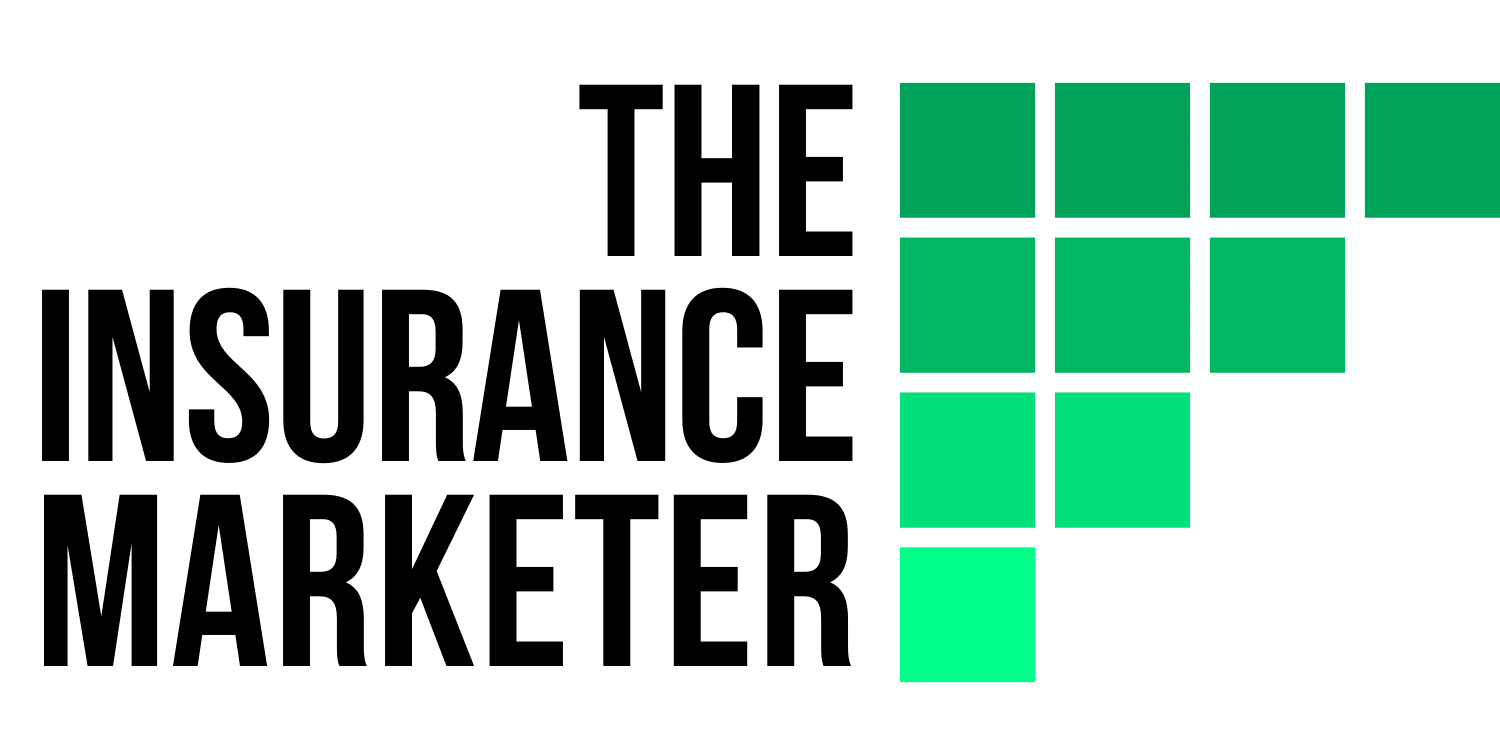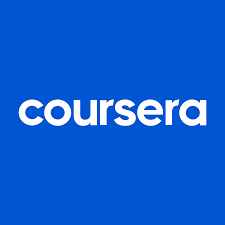Most reviews you can find on Linkedin Learning spend a lot of time giving you in-between answers and only focus on the features of the platform itself. Very few actually talk about the benefits it brings – a.k.a. how it helps you do your job (or even make your life) better at any level of your career.
In this article, I take the approach of sharing my own learning experience as a subscriber. And I will also explain why I like it and how I use it from a marketer’s perspective.
And Because We Are Marketers
Let’s dive right in. Under the sub-category of “Marketing” alone, there are already over 2800 search results.
We are curious, we are hungry, we are versatile, and we never settle. And most importantly, we want more for less.
At first glance, it may be hard for any marketer to resist from immersing ourselves in as many marketing niches as we ever have the time for – be it B2B Marketing, B2C Marketing, Content Marketing, Email Marketing, Marketing Automation, Social Media Marketing, PPC, SEO, and many more.
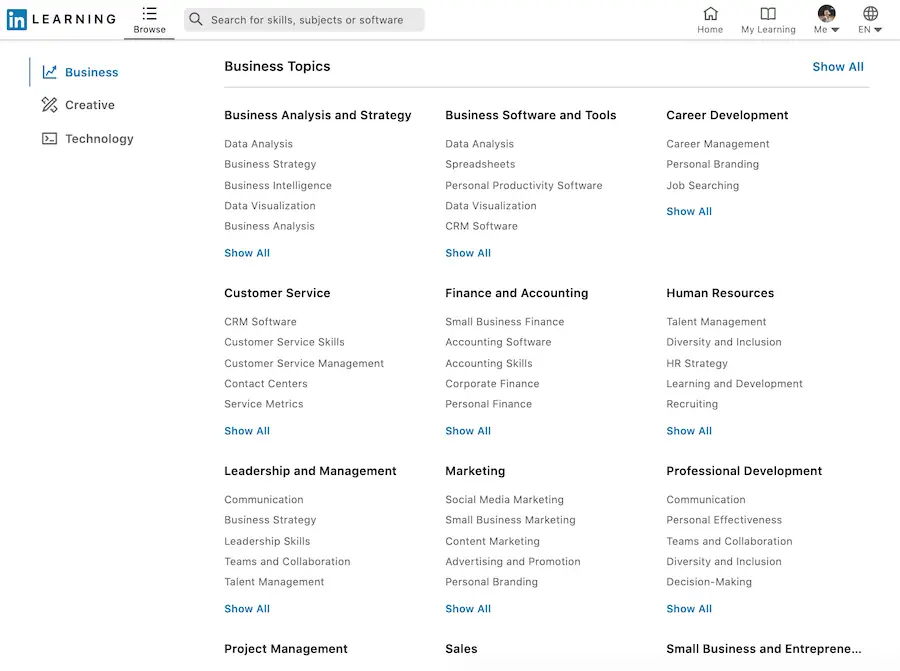
You will find yourself not only learning from any marketing-related course like Guy Kawasaki on How to Rock Social Media, (Yes! the Chief Evangelist of the online design guru Canva.com) but also many others that you may not have thought you would have done so, such as Design Thinking Approach to Putting the Customer First, The Monster Drawing Workshop, and Productivity Hacks for Writers.
With unlimited access in a subscription, your time is the only limit.
How to rock social media from Guy Kawasaki on How to Rock Social Media by Guy Kawasaki
What’s Inside? An Intuitive Categorization of 16000+ Job-Based Courses to Brush Up Your Skills
Linkedin Learning positions itself as the go-to platform for anyone who wants to learn skills to achieve their personal and professional goal. In fact, it is probably one of the most career-focused online course providers in the market.
At the time of writing, there are over 16000 expert-led online courses to choose from. Courses are organized under three main categories:
- Business – Business Analysis and Strategy, Leadership and Management, Finance and Account, Sales, Marketing, Customer Service, Human Resources, and more.
- Creative – Design Thinking, Motion Graphics, Video Production, Graphic Design, Product and Industrial Design, Animation and Illustration, Photography, and more.
- Technology – Cloud Computing, Data Science, Database Management Network and System Administration, Web Development, Software Development, Mobile Development, and more.
A Simple And Personalized Dashboard To Keep You On Top of Your Learning
Linkedin Learning has demonstrated the best practices in design thinking and UI/UX with their home page perfectly.
Any first-time users will instantly know where they are at and where to go next from there. I think they have nailed it in two aspects. Let’s take a closer look:
- Keeping the navigation clean and user-friendly – Once you’ve logged in, you are directed to a personalized dashboard. On top of the web interface, you can find:
- The Top Banner: This block shows a selection of newly released courses.
- Weekly goal: You may set a weekly goal for how many hours you want to learn, and track your progress along the way.
- In progress: It shows the courses you are currently learning.
- Saved: Any course you saved are stored here as your shortcut.
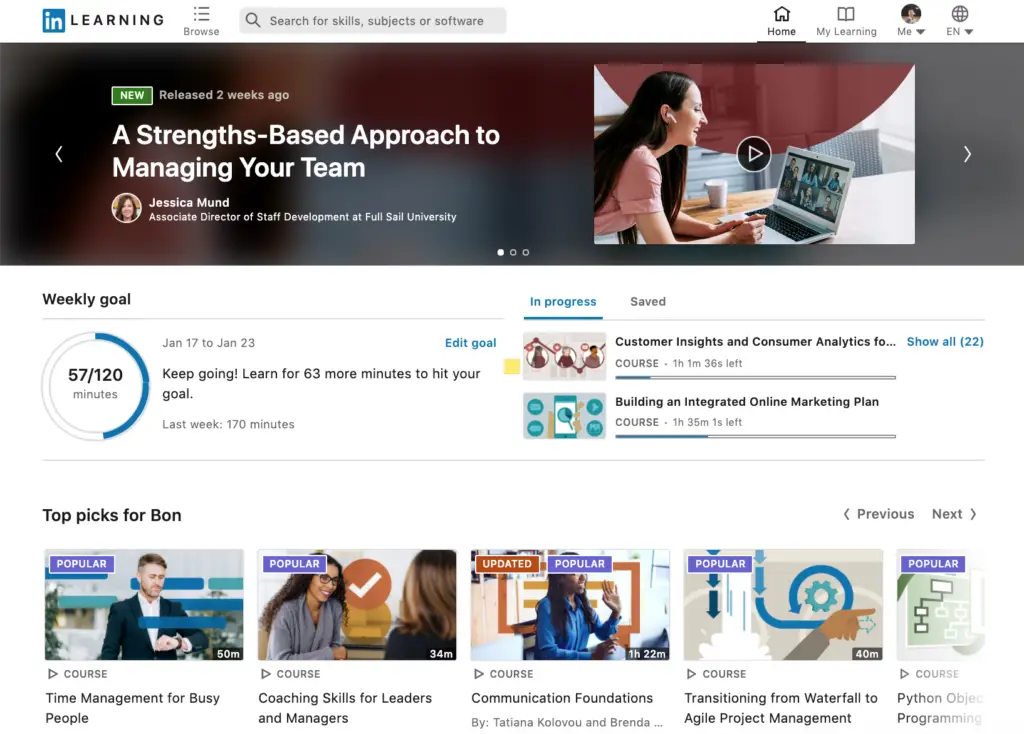
- Making course suggestions relevant to your interest, Linkedin profile, and your industry – Anything below works similar to “people also buy” as in Amazon, based off of what you’ve learnt, shown interested in, and information from your Linkedin profile.
For example, since I have been taking their courses on marketing, their “Top picks” for me are showing courses in the likes of Marketing on Linkedin: The Sophisticated Marketer’s Guide, Design Thinking: Data Intelligence, and Growth Hacking Tips.
And since I also put “Drawing” and “Linkedin Marketing” as the skills that I am interested in (under My Learning page), I can have direct access to relevant course suggestions in the carousel slider.
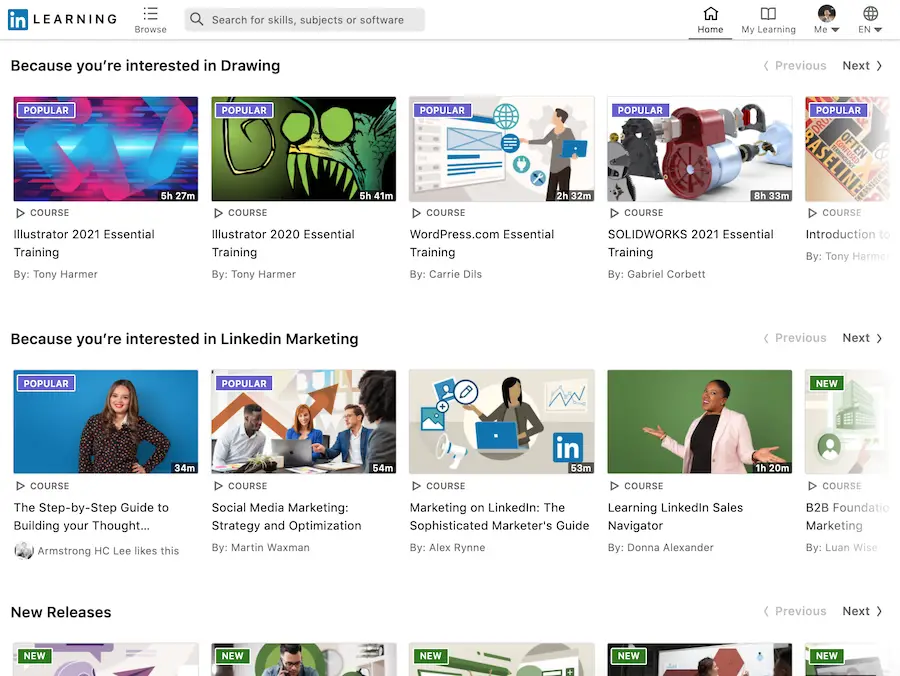
Well-Structured Courses With High-Quality Video
Most LinkedIn Learning courses are primarily video-based. They are produced with professional sound and video quality that makes the learning experience smooth and pleasant.
The course dashboard is well-structured and easy to use. Here’s how it works on the desktop interface:
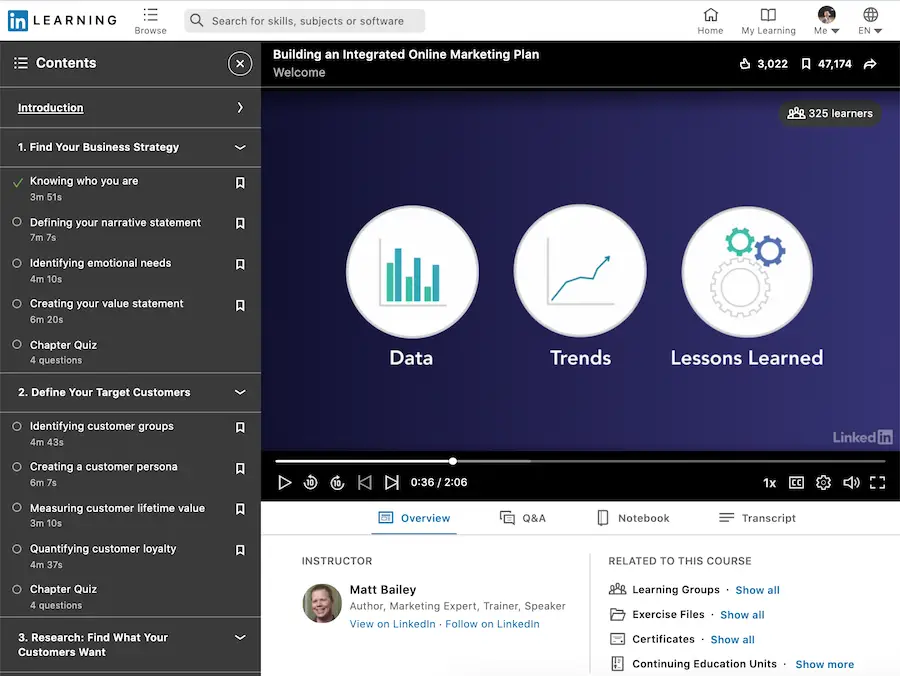
Table of Content – This is straight forward. But the best thing about the table of content is that you always know where you are at, and you can jump from here and there without getting lost.
Overview – Under this tab, you will find further information to decide whether this course is right for you. From here you will see a brief profile of the instructor, the course details, and the learning objectives of the course.
Other sections on this page such as Q&A, Notebook ,Transcripts are self-explanatory, so I don’t think I should go throught them for the interest of your time.
How Do I Get The Most Out of My Subscription?
Like many of you, I was a bit skeptical about entering my credit card number in exchange for the free trial. I even marked my calendar to remind myself to cancel my subscription one month afterward.
But before the month ended, I knew it’s unnecessary and I decided to keep my subscription.
And here are a few examples of how I learn to make use of Linkedin Learning to do my job better and more efficiently:
As a research tool to enrich the content of a blog post – Before writing a blog post, I would usually check the competition by putting in the keywords in Google. Then I’d read the blog posts from the first two pages off of the search result.
In this way, I would be able to get an idea of the quality of the content out there and decide how I should approach the post to bit the competition.
Enter Linkedin Learning.
On top of reading similar blog posts, taking a course taught by industry professionals can certainly level up my content with more insights, examples and authenticity.
And oftentimes, if I spotted a related course that is super helpful for readers to better understand the topic, I would just embed the video link in the blog post. Here’s how I did it with these 2 posts:
To learn and refresh job-related skills quickly – When I come across new projects in a domain that requires some sort of new skills, I would check related courses on Linkedin Learning to learn whatever I can in a very short period of time.
Earlier I was approached by an ex-colleague to help him work out a marketing plan for a healthcare startup. Right away I just searched for “healthcare” on Linkedin Learning and see what I can learn real quick.
And I was happy to find courses like Project Management: Healthcare Projects or Selling into Industries: Healthcare. Before I start writing, I jumped right into the course Creating Your Strategic Marketing Plan I saved earlier for an immediate refresher.
To explore what it takes to be in someone else’s role – From time to time I have to work with people with different backgrounds and skillsets. I found it quite useful to understand some basic skills and concepts in their domain in order to build rapport with them.
Linkedin Learning has structured Learning Paths with sets of courses grouped together for various job roles. For example, if I type “become” in the search box, it will return with a list of job roles.
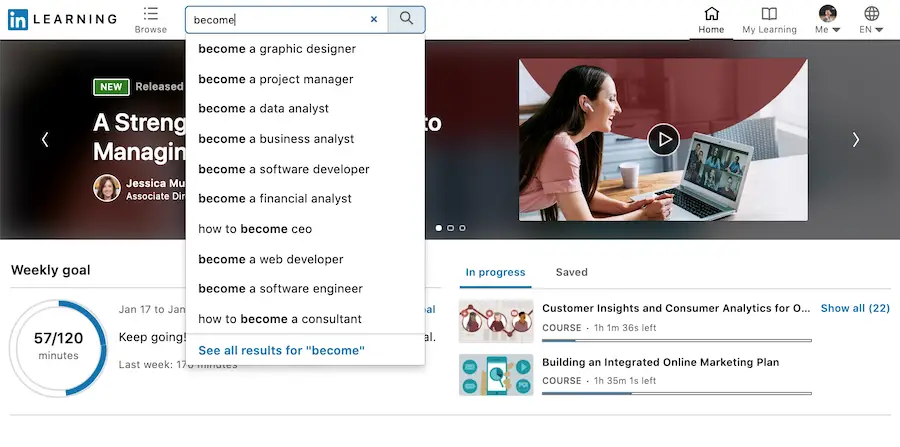
This function will also be very useful for anyone who is looking to transition into a new domain. Say if you are interested in becoming a project manager, you can just click inside to get a sense of what skills are taught in the pack.
Unlimited Access – As Low As $19.99 Per Month
After the trial period, you have two payment options:
LinkedIn Learning has a generous, full-featured, 1-month free trial. You get everything of the paid version, including all-access to the 16000+ course, resources download and learning certificates to show on your Linkedin Profile. No question asked.
- Monthly plan: $29.99 per month.
- Yearly plan: $239.88 per year (or $19.99 per month).
If you are still not convinced, sign up for the free trial and try to explore these extra features that come in free with the subscription:
Free LinkedIn Premium upgrade – it includes features to check who has viewed our Linkedin profile, seeing more of other profiles when you search, access to premium search filters, InMail and more. The basic plan starts at $24.95 per month. And it comes free with your Linkedin Learning subscription.
Free certificate – Although LinkedIn Learning does not provide accredited educational material, you can display buy learning outcome by displaying certifications and badges on your Linkedin profile.
I find it very encouraging, especially if you are acquiring new skills to show your future employers. Here’s how the badges look like on my LinkedIn profile:
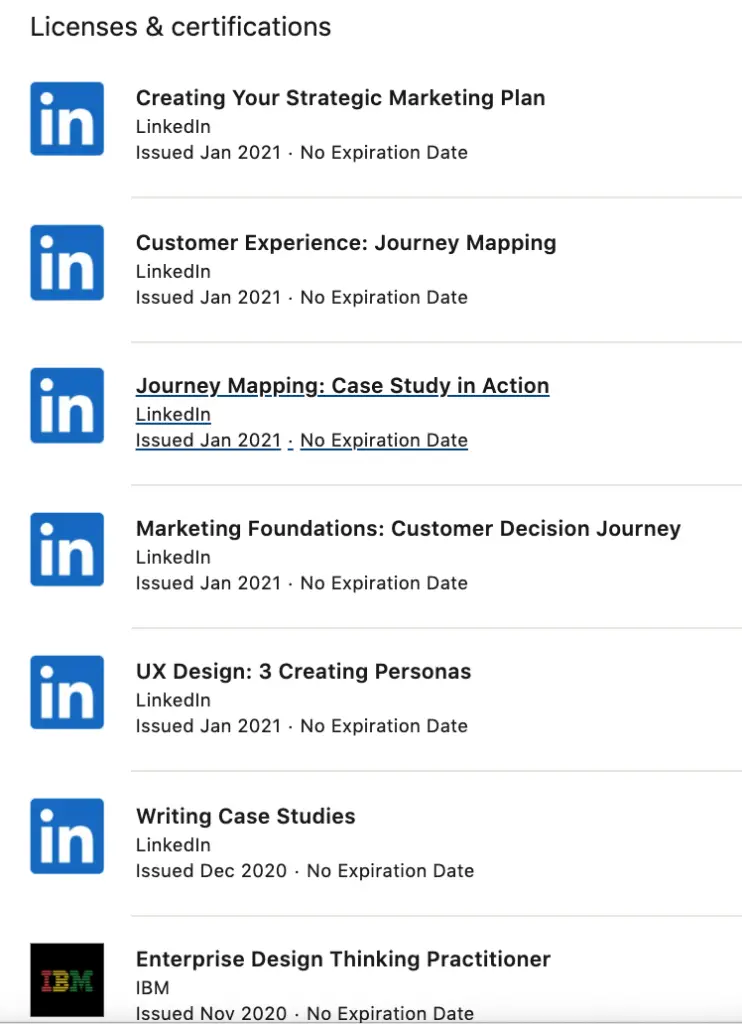
Free exercise files – This is rarely mentioned in most of the reviews, but I think it is a gold mine. Most of the courses come with exercise files, which are worksheets or templates you can download and start using right away.
Free App – Different people learn differently. With the mobile app, you can absorb the material on the go. (much like the experience of Audible)
Over To You
I hope this post has provided you with some real use cases for getting most out of Linkedin Learning as a marketer. And I know you would add on to this list according to your need.
I really don’t care what people say whether it’s worth the price or the fact that it has no accreditation. I only know I have an in-demand knowledge base at my back whenever new projects come up. What’s next is to try it out for yourself. Cheers!
